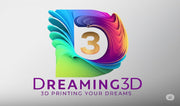Ever wondered how a digital idea on a screen becomes a solid object you can hold in your hand? 🤔 It’s not magic—it’s the powerful partnership between computers and 3D printing. This dynamic duo is changing the game in everything from engineering and medicine to art and hobbyist workshops. Let's dive into how your computer acts as the ultimate brain behind the brawn of a 3D printer.
The Digital Blueprint: Designing Your Dream
It all starts with a thought. But to bring that thought to life, you need a digital blueprint. This is where 3D modeling software comes in.
Using powerful Computer-Aided Design (CAD software), creators can design, sculpt, and refine a virtual object with incredible precision. Whether you're engineering a custom drone part, designing a unique piece of jewelry, or creating a miniature for your tabletop game, the computer is your digital workshop. Once the design is perfect, it's typically saved as an STL file—a standard format that represents the surface geometry of your 3D model. This file is the key that unlocks the door to the physical world.
The Translator: Slicer Software
Your 3D printer doesn't understand the complex geometry of an STL file directly. It needs a translator, and that's the job of slicer software.
The slicer is a brilliant piece of programming that "slices" your 3D model into hundreds or thousands of ultra-thin horizontal layers. It then generates a file of instructions, known as G-code, which is the step-by-step roadmap for the printer. The slicer allows you to fine-tune crucial 3D printer settings, such as:
• Layer height: Determines the resolution of your print.
• Infill: The internal structure that gives your object strength.
• Print speed: A balance between speed and quality.
• Supports: Temporary structures for printing complex overhangs.
Mastering your slicer is essential for achieving high-quality custom 3D prints.
The Execution: Bringing the Model to Life
With the G-code loaded, the 3D printer takes over. The computer—or more accurately, the microcontroller inside the printer—reads the G-code line by line. Each command tells the printer exactly where to move, how much filament to extrude, and what temperature to maintain.
This process, known as additive manufacturing, builds the object layer by minuscule layer. Whether it's a popular FDM printer melting plastic filament or a resin printer curing liquid with UV light, the computer is the conductor orchestrating a symphony of precise movements to create a flawless final product. From rapid prototyping new inventions to producing functional prototypes, this technology offers unparalleled speed and flexibility.
Unlock Your Creativity!
The synergy between computers and 3D printing has torn down the barriers between imagination and reality. It empowers engineers, artists, and hobbyists to create bespoke solutions and tangible art right from their desktops. The next time you see a stunning 3D-printed object, remember the incredible digital journey it took—from a spark of an idea in a designer's mind, through the intricate processing on a computer, to a physical object built with robotic precision.
Ready to turn your own digital dreams into reality? Exploring 3D printing services can be a great way to bring your creative projects to life without needing your own hardware. The possibilities are truly endless! ✨
